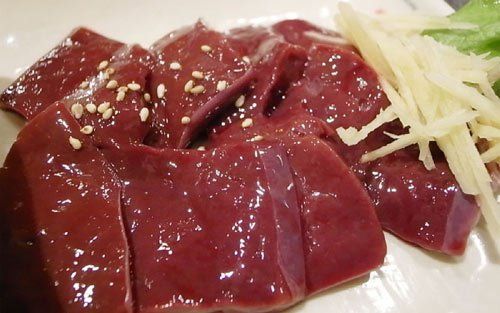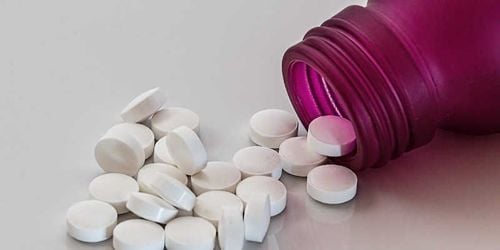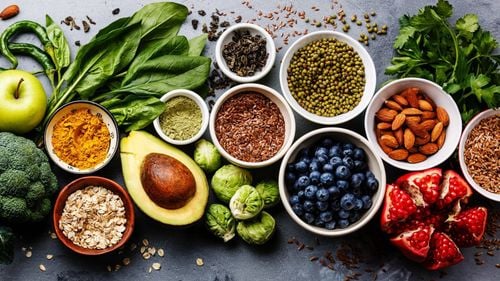This is an automatically translated article.
There are a variety of healthy foods. However, eating too much is not always good. Some foods can be good if consumed in moderation, but can cause serious harm if eaten in large amounts. Here are 8 foods that are healthy but can be harmful if eaten in excess.
1. Omega - 3 and fish oil
Omega-3 fatty acids are essential for our health. It has anti-inflammatory effects in the body, plays an important role in brain development, reduces the risk of cardiovascular disease,... Most people today have a diet that does not provide it. enough Omega-3 for the body. Therefore, many people have used Omega-3 supplements in capsule form (made from fish, fish liver and seaweed).
However, eating too many foods or supplements containing Omega-3 can be harmful. The usual dose ranges from 1-6g/day. However, doses up to 13-14g/day can thin the blood in healthy people. This also carries potential risks, especially in people who bleed easily or are taking blood thinners. Moreover, using a lot of cod liver oil can cause an excess of vitamin A, causing vitamin A toxicity. This is a serious problem for children and pregnant women.
2. Tuna (fresh and canned)
Tuna is a fatty fish and is considered a healthy food. It is rich in Omega-3 fatty acids and protein. However, tuna can also contain high levels of the environmental pollutant methylmercury. At higher levels, methylmercury is a neurotoxin that can cause many adverse health effects. Specifically, it can lead to growth retardation in children, vision problems, lack of coordination, impaired hearing and speech,...
Large tuna contains a lot of mercury. because it builds up in the fish's tissues over time. It is often made into grilled fish or used in sushi dishes. Smaller tunas contain lower amounts of mercury and are usually canned.
There are 2 types of canned tuna with different levels of mercury. They are:
Tuna: Light in color, usually albacore. This fish contains 4-5 times more mercury than light tuna; Light tuna: Contains much less mercury than white tuna. It is a darker color, usually not an albacore fish. The safe limit for human consumption of methylmercury is 0.1 micrograms/kg body weight. This means that a 25kg child can only eat one 75g serving of canned white tuna every 19 days. Consuming more than this will exceed the recommended limit. Pregnant women and children should limit eating seafood containing mercury (unhealthy food) to no more than 2 times a week.
There are some other fish that are also rich in Omega-3 fatty acids but are less contaminated with mercury, such as salmon, mackerel and sardines.

Một trong những lời khuyên của chuyên gia là không ăn quá nhiều thực phẩm như cá ngừ
3. Cinnamon
Cinnamon is a delicious spice that is now widely used and has a number of healing properties. It's packed with antioxidants, which have been shown to fight inflammation and lower blood sugar. Eating cinnamon also helps reduce the risk of cardiovascular disease, diabetes, cancer, and neurodegenerative diseases. However, this spice contains large amounts of the compound coumarin, which can be harmful if consumed in large doses. There are 2 types of cinnamon with different amounts of coumarin:
Cassia: Contains a relatively high amount of coumarin; Ceylon: A less common type of cinnamon, containing less coumarin. The recommended amount of coumarin tolerable daily is 0.1 mg/kg body weight. Consuming more than this can cause liver toxicity and cancer. Based on tolerable daily intake, no more than 0.5-2g of Cassia cinnamon per day should be consumed per person. However, you can eat up to 5g (1 teaspoon) of Ceylon cinnamon/day.
Occasionally, you can eat more than is recommended, if a recipe calls for a lot of cinnamon. However, you should not eat large amounts of cinnamon too often.
4. Nutmeg
Nutmeg is a spice with a unique flavor, often used in cakes, puddings. It contains the compound myristicin - a psychostimulant.
In low doses, nutmeg makes dishes more delicious without affecting health. However, in large doses, nutmeg can cause myristicin toxicity. Symptoms of myristicin poisoning include arrhythmias, seizures, nausea, dizziness, pain, and hallucinations. Therefore, it is not recommended to eat more than 10g of nutmeg in one sitting. Doses higher than recommended may cause symptoms of toxicity.
5. Coffee
Coffee is a wonderful drink that is rich in antioxidants and other active compounds. It is considered a healthy food with many benefits such as reducing the risk of liver diseases, type 2 diabetes and neurodegenerative diseases.
The good ingredient in coffee is caffeine, each cup contains an average of 80 - 120mg of caffeine. Consuming 400 mg/day is considered safe. However, consuming more than 500mg/day would be excessive. This affects the nervous system, causing insomnia, nervousness, irritability, stomach cramps, muscle tremors and heart palpitations.
The amount of caffeine that can cause side effects varies from person to person. Some people can drink as much coffee as they want, while others experience unpleasant symptoms even with small amounts of caffeine.
6. Animal liver
Viscera is the most nutritious part of an animal, and the liver is the most nutrient-dense organ. It is rich in essential nutrients such as vitamin A, vitamin B12, iron and copper. However, 100g of beef liver contains 6 times the recommended dietary intake of vitamin A and 7 times the recommended daily intake of copper.
Vitamin A is a fat-soluble vitamin that is stored in the body. An excess of vitamin A from eating animal liver can cause symptoms of vitamin A toxicity. These symptoms include vision problems, bone pain, increased risk of bone fractures, nausea, and vomiting.
Eating too much liver will add too much copper to the body, causing copper poisoning. This can lead to oxidative stress and neurodegenerative changes, which may increase the risk of Alzheimer's disease. Therefore, although liver is a healthy and very nutritious food, you should not consume it every day. Just eat liver once a week is enough.

Gan là thực phẩm không tốt cho sức khỏe
7. Cruciferous vegetables
Cruciferous vegetables are a family of green vegetables, which includes broccoli, kale, cabbage, collard greens, and Brussels sprouts. This group of vegetables has many health benefits such as helping to reduce the risk of cardiovascular disease and cancer. Cruciferous vegetables also make up a large part of people's daily vegetable intake. They are also a familiar ingredient in smoothies and vegetable juices.
However, compounds found in cruciferous vegetables called thiocyanates can interfere with the body's ability to absorb iodine. This can cause hypothyroidism. Hypothyroidism is an underactive thyroid condition. Symptoms include an enlarged thyroid gland, weight gain, constipation, dry skin and decreased energy levels... So while cruciferous vegetables like broccoli are healthy, they are also healthy. should not be used too much, especially for people who are sensitive to thyroid problems.
8. Brazil Nuts
Brazil nuts are one of the best sources of selenium. Selenium is an essential trace element but can be toxic if consumed in large amounts. Symptoms of selenium toxicity include hair and nail loss, digestive problems, memory problems,...
The recommended daily intake of selenium is 50 - 70 micrograms/day for adult. A safe intake is about 300 micrograms/day for adults.
1 A large Brazil nut can contain up to 95 micrograms of selenium - more than the daily recommended amount for adults and 3 times the recommended amount for children. Just eating 4-5 Brazil nuts is already above the safe selenium intake threshold. So you shouldn't eat more than that.
The foods in the above list are all very healthy. However, if consumed in excessive amounts, they can become unhealthy foods. Therefore, users need to consume the recommended amount of food.
Please dial HOTLINE for more information or register for an appointment HERE. Download MyVinmec app to make appointments faster and to manage your bookings easily.
Reference source: healthline.com













